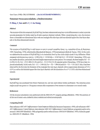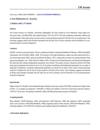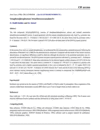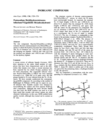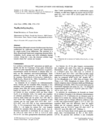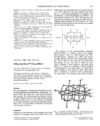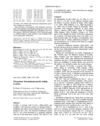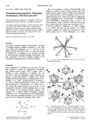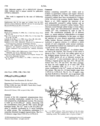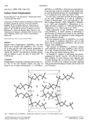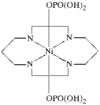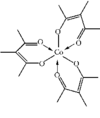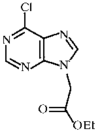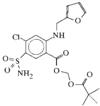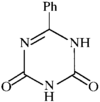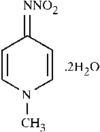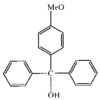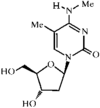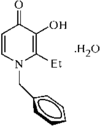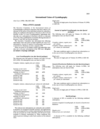issue contents
December 1998 issue

Cover illustration: Tetrakis(tetramethylammonium) Dihydrogendecavanadate Acetic Acid 2.8-Hydrate, see Pecquenard et al., pages 1833-1835. Displacement ellipsoids are shown at the 50% probability level.
cif-access (inorganic compounds)
Download citation


Download citation


The structure of K3[Co(CN)6] has been redetermined to provide more precise bond lengths and angles for shielded tensor calculations using density functional theory (DFT) methods. The three-dimensional network structure contains rectangular and distorted square channels.
Download citation


Download citation


Distrontium diphosphate, alpha-Sr2P2O7, has been refined in the Pnma space group. However, the strong anisotropy along the b direction for some of the O atoms suggests atomic scale disorder associated with the local loss of mirror symmetry and centrosymmetry.
Download citation


Download citation


Tetraphenylphosphonium tetrachlorooxovanadate(V) consists of anionic [OVCl4]− square pyramids with local C4v symmetry. The V-O distances are 1.565 (3) Å, V-Cl is 2.2660 (6) Å, and the V atom is placed 0.527 (1) Å above the basal plane. The slightly squeezed tetraphenylphosphonium cations occupy positions with local S4 symmetry.
cif-access (metal-organic compounds)
Download citation


Download citation


The structure and synthesis of the title compound are described. The asymmetric unit contains two molecules which display different hapticity.
Download citation


Download citation


The title compound shows a distorted square-planar coordination geometry with an S2N2 donor set and a long-range apical interaction to the third S-atom donor.
cif-access (organic compounds)
Download citation


Download citation


The title compound crystallizes in space group P21/n. The oxalate mono-anion deviates considerably from planarity. The structure is stabilized by an extensive network of N-H⋯O and O-H⋯O hydrogen bonds.
Download citation


Download citation


The title compound, 1-[phenyl(1,4-selenazan-4-yl)methyl]pyrrolidine-2,5-dione, exists as a monomeric molecule whose selenamorpholinyl unit adopts a chair-shaped conformation.
Download citation


Download citation


The first two representatives of alkoxynitrosoamines, namely, N,N'-dimethoxy-2,3-dimethyl-N,N'-dinitroso-2,3-butanediamine and N-formyl-N,N'-dimethoxy-2,3-dimethyl-N'-nitroso-2,3-butanediamine, have been studied and are isomorphic.
Download citation


Download citation


The title compound was synthesized in two steps from phenylthioacetic acid. The molecular packing is stabilized by short C-H⋯O intermolecular hydrogen bonding and a network of van der Waals contacts.
Download citation


Download citation


The title compound belongs to the family of bicyclo[2.2.0]hexanes. The C1-C4 and C3-C4 bond lengths [1.607 (3) and 1.592 (3) Å, respectively] of the two four-membered rings are significantly longer than the average bond length for such ring systems [1.554 (21) Å], which is obviously a result of angular strain.
Download citation


Download citation


The title molecule appears to be approximately planar and is found to be in the E conformation. An intramolecular hydrogen bond is formed between the NH group and the adjacent nitro group.
Download citation


Download citation


The molecules of the title compound are linked to form centrosymmetric dimers by O-H⋯O hydrogen bonds. The C=O distance [1.225 (4) Å] is slightly longer than the standard distance range for such dimers (1.205-1.215 Å) and the C-O(H) distance [1.293 (3) Å] is slightly shorter than the standard distance of 1.308 Å.
inorganic compounds
Download citation


Download citation


The title compound contains discrete centrosymmetric [Au{TeO4(OH)2}2]5− anions in which the hydroxy H atoms have been located.
Download citation


Download citation


The structure of Na5Bi2(AsO4)(As2O7)2, prepared by solid-state reaction, contains BiO6 octahedra and AsO4 tetrahedra sharing corners to form a three-dimensional framework. The structure exhibits large tunnels where Na+ cations are located.
Download citation


Download citation


(NH4)4Na2[Mo2VIV2VV6O28].10H2O is a mixed V/Mo salt which has a well known decavanadate structure. The centrosymmetric polyanion consists of eight (V/Mo)O6 and two VO6 edge-sharing distorted octahedra.
Download citation


Download citation


The asymmetric unit of the structure of (NP2Cl6)PCl6 contains two [N(PCl3)2]+ cations, both of which adopt trans-trans conformations, and two octahedral PCl6− anions.
Download citation


Download citation


Cs3ZnI5 is isotypic with Cs3CoI5, The structure consists of distorted [ZnI4]2− tetrahedra and chains of face-sharing [Cs6I]5+ octahedra parallel to the x axis.
Download citation


Download citation


The crystal structure of the title compound includes a nine-coordinate UIV center stitched together through hydrogen bonding with the counter-anions and molecule of solvation.
Download citation


Download citation


K3TaS4 crystallizes with the K3VS4-type structure, based on discrete tetrahedral TaS43− anions, which are connected via K+ cations.
Download citation


Download citation


A new dimeric ammonium cerium(IV) sulfate has been synthesized and its structure determined by single-crystal X-ray analysis.
Download citation


Download citation


Sodium nickel polyphosphate is unlike other AM(PO3)3 (A = alkali metal and M = transition element) complexes, but resembles AgM(PO3)3 (M = Zn, Co, Ni or Mg). Columns of alternating Na and Ni atoms lie between the `zigzag' polyphosphate chains.
metal-organic compounds
Download citation


Download citation


Download citation


Download citation


Download citation


Download citation


Download citation


Download citation


Download citation


Download citation


Download citation


Download citation


Download citation


Download citation


Download citation


Download citation


Download citation


Download citation


Download citation


Download citation


Download citation


Download citation


Download citation


Download citation


Download citation


Download citation


Download citation


Download citation


Download citation


Download citation


Download citation


Download citation


Download citation


Download citation


Download citation


Download citation


Download citation


Download citation


Download citation


Download citation


Download citation


Download citation


Download citation


Download citation


Download citation


Download citation


Download citation


Download citation


Download citation


Download citation


Download citation


Download citation


Download citation


Download citation


Download citation


Download citation


Download citation


Download citation


Download citation


Download citation


Download citation


Download citation


Download citation


Download citation


Download citation


Download citation


Download citation


Download citation


Download citation


Download citation


Download citation


Download citation


Download citation


Download citation


Download citation


Download citation


Download citation


Download citation


Download citation


Download citation


Download citation


Download citation


Download citation


Download citation


Download citation


Download citation


Download citation


Download citation


Download citation


Download citation


organic compounds
Download citation


Download citation


Download citation


Download citation


Download citation


Download citation


Download citation


Download citation


Download citation


Download citation


Download citation


Download citation


Download citation


Download citation


Download citation


Download citation


Download citation


Download citation


Download citation


Download citation


Download citation


Download citation


Download citation


Download citation


Download citation


Download citation


Download citation


Download citation


Download citation


Download citation


Download citation


Download citation


Download citation


Download citation


Download citation


Download citation


Download citation


Download citation


Download citation


Download citation


Download citation


Download citation


Download citation


Download citation


Download citation


Download citation


Download citation


Download citation


Download citation


Download citation


Download citation


Download citation


Download citation


Download citation


Download citation


Download citation


Download citation


Download citation


Download citation


Download citation


Download citation


Download citation


Download citation


Download citation


Download citation


Download citation


Download citation


Download citation


Download citation


Download citation


Download citation


Download citation


Download citation


Download citation


Download citation


Download citation


Download citation


Download citation


Download citation


Download citation


Download citation


Download citation


Download citation


Download citation


Download citation


Download citation


Download citation


Download citation


Download citation


Download citation


Download citation


Download citation


Download citation


Download citation


Download citation


Download citation


Download citation


Download citation


Download citation


Download citation


Download citation


Download citation


Download citation


Download citation


Download citation


Download citation


Download citation


Download citation


Download citation


Download citation


Download citation


Download citation


Download citation


Download citation


Download citation


Download citation


Download citation


Download citation


Download citation


Download citation


Download citation


Download citation


Download citation


Download citation


Download citation


Download citation


Download citation


Download citation


Download citation


Download citation


Download citation


Download citation


Download citation


Download citation


Download citation


Download citation


Download citation


Download citation


international union of crystallography
Free 



 journal menu
journal menu











